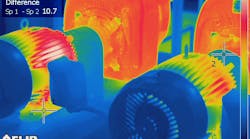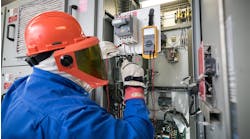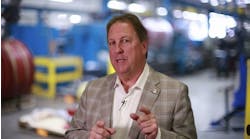The typical motor preventive maintenance (PM) procedure is concerned with the motor, but not with its environment. This is a weakness. Many of these associated issues can be addressed once and forgotten (at least for a long time), but the key is to actually address them. Here are a few to look at:
- Voltage imbalance. Calculating this is a bit convoluted and includes, among several other steps, determining the average voltage between phases. For equipment generally, 4% is considered the point at which you should take corrective action. But for most motors, an imbalance of 3.5% brings a 25% rise in temperature. You can see the excess heat effects of even a 2% voltage imbalance by looking at the windings with a thermographic camera (if the motor is vented in a way that permits that).
- Load issues. Load issues often show up as excess vibration, but not always. For example, side-loading of the motor shaft can exist even if you’re not seeing excess vibration. Also, front-to-back displacement of the load can accelerate bearing wear without causing excess vibration. Thermographic analysis of the motor bearings (particularly the thrust bearing) can reveal these kinds of issues.
- Ambient temperature. The higher the ambient temperature, the harder it is for a motor to dissipate heat. In one plant, installing a passive (no fan) ventilation panel in each of two opposing exterior walls of the air compressor room brought the room temperature down by about 20 degrees. The motor temperature dropped by almost as much.
- Ambient air flow. Increasing the air flow around a motor can significantly extend its life. For this reason, some process equipment is designed with filtered air ducts to cool motors that are practically buried in the equipment. Those filters must be cleaned or replaced periodically, to maintain air flow. If a motor is in tight quarters and runs hot, consider fans or ducting to help cool it. Also look for anything nearby that might be obstructing natural airflow and could be moved.
- Bonding of nearby objects. Bonding metallic objects brings them to the same potential and eliminates undesired current flow (no voltage means no current) and problems like flashover. If you see ground rods on the load side of the service (or other source), suspect bonding deficiencies.
- Physical protection. This includes protecting the motor from process waste (scrap clogging the motor vents, liquid dripping onto the motor, etc.). But it also includes protecting the motor base and pedestal from lift trucks. In one plant, the cause of repeated vibration problems was finally discovered when an electrician noticed the weights of a lift truck bumping the motor base as the lift was backing up. This was solved with a couple of bollards.




